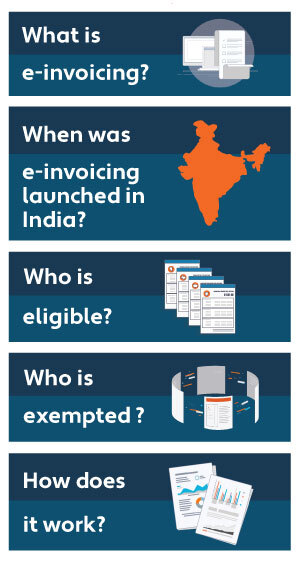
Basics of e-invoicing
After the successful launch of its first three phases, the Government of India is all set to roll out phase 4 of e-invoicing. This new phase will be implemented on April 1, 2022. If you’re not sure what e-invoicing is or how it applies to your business, here’s everything you need to know about e-invoicing in India.

Let’s start with the basics. What is e-invoicing?
Simply put, e-invoicing or electronic invoicing is the process of validating a transaction invoice from a Government empaneled e-invoice portal. Using e-invoicing, businesses can authenticate and validate their invoice. The details of the authenticated invoice are then replicated in the business’s GST returns, e-way bills, etc, and facilitate easier and seamless calculation and tracking of applicable tax liabilities.
When was e-invoicing launched in India?
So far, e-Invoicing has been rolled out in three progressive phases. The first phase of e-Invoicing in India was supposed to be implemented in the first quarter of 2020. However, due to the COVID-19 pandemic, the initial implementation was pushed from early 2020 to October 2020. The first phase of e-invoicing in India was applicable only on business-to-business transactions made by organizations with an annual turnover exceeding ₹500 crores. The second phase expanded e-invoicing applicability to businesses with an annual turnover exceeding ₹100 crores. Last year on 1st April 2021, the Government introduced the third phase of e-Invoicing, bringing businesses with an annual turnover exceeding ₹50 crores under e-invoicing. As you can see, in each phase of e-invoicing, the Government has expanded the annual revenue threshold for businesses.
Now, the fourth phase of e-Invoicing in India will be implemented from April 2022 and will be applicable to businesses with an annual turnover of ₹50 crores.
Who is eligible for e-invoicing?
The following table explains which businesses are subject to e-invoicing.
Annual turnover threshold | E-Invoicing applicable from |
Exceeding ₹500 crores | October 1, 2020 |
Exceeding ₹100 crores | January 1, 2021 |
Exceeding ₹50 crores | April 1, 2021 |
Exceeding ₹20 crores | April 1, 2022 |
Who is exempted from e-invoicing?
Some businesses might not be required to take up e-invoicing even if they fall under the prescribed annual turnover threshold. These businesses include -
- Banking and insurance companies or financial institutions, including Non-Banking Financial Corporations,
- Registered persons supplying passenger transportation services
- Goods Transport Agencies (GTA)
- Registered persons supplying services by way of admission to the exhibition of cinematographic films in multiplex services
- SEZ units
How does e-invoicing work?
E-invoicing under the Goods and Services Tax requires businesses to register all B2B transactions with the Government authorised Invoice Registration Portal (IRP). Once an organization uploads the specified particulars on to the IRP, the portal will mark the invoice with a unique Invoice Reference Number (IRN) and a Quick Reference (QR) code. This IRN and QR code must be printed on the invoice or must be mentioned on e-way bills for quick inspection at revenue check points.
It must be noted that only a registered e-invoice with IRN is considered to be valid and non-adherence will result in non-compliance.The aim of adopting an e-invoice system by tax departments is to allow pre-population of fields while filing returns leading to a reduction in reconciliation problems. However, that is just one of the advantages of e-invoicing. Adopting an e-invoicing system leads to a significant increase in technological sophistication and an increased penetration of the Internet along with the availability of computer systems at reasonable costs. This is probably why more than 60 countries across the globe have already adopted or are in the process of adopting e-invoicing.
Prepare your business for e-invoicing under GST
Discover how to meet all compliance requirements while integrating e-invoicing into your tax function.

Stay up to date
Sign up for our free newsletter and stay up to date with the latest tax news.



